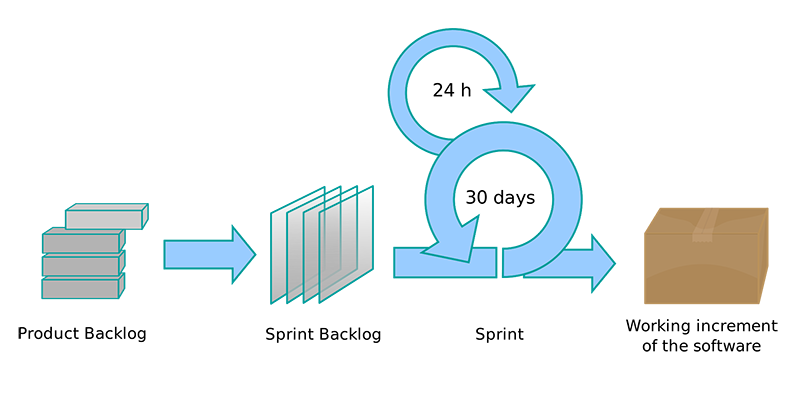
Agile Software Development: 12 Principles Changing the Software Life Cycle
Different companies adopt different methods of management for software development, but one of the most common is agile. Agile software development focuses on the process, not the plan. The basic idea behind agile software development is the ability to respond to change as it happens. It prioritizes the result over the path taken to get there. In an agile environment, expect to see less documentation and more drive to working solutions.
What is Agile Methodology?
Those who are new to agile principles and methods might think that there is no methodology to agile, but that is not the case. Agile incorporates a method that is less structured and less linear than traditional planning. Agile development is adaptive, not predictive. That means that a team using agile methodology might not be able to tell you a specific set of steps and completion dates early in a project, but they will be able to talk about major milestones and expected value vs. cost.
The 12 Principles that Make Up Agile Software Development
When agile was formalized with the release of the "Agile Manifesto" in 2001, the 17 software developers that wrote it devised 12 principles that define this methodology.
- Customer satisfaction is the number one priority, with early and continuous software delivery the methodology.
- Customer needs change, even late in the development process. Agile methods are able to adapt to these changes.
- Faster software delivery is an important priority. Builds should release as quickly as possible, with timelines ranging from weeks to a couple of months.
- Collaboration is key, with business people and developers working side-by-side on a daily basis to move a project to completion.
- Find the right team members for each project and trust them to deliver in a supportive environment.
- Schedule frequent face time. Direct conversation is the most efficient way to communicate.
- Software delivery is the best KPI (Key Performance Indicator) for a development team.
- Consistency and sustainability are the foundations for agile processes. Release schedules should be at a pace developers can meet indefinitely.
- Technical excellence and good design depend on attention to detail.
- Streamline processes to avoid duplication and extra work.
- Self-organizing teams produce the best results.
- Scheduled review sessions among team members help identify issues and improve results.
These principles guide the process for software development using this method. In practice, Scrum and XP are some of the most common implementations of these principles.
What is Scrum?
Scrum is an agile methodology that focuses on how to assign teams and tasks. Each Scrum team is fully functional and capable of producing all needed material to complete a project. When using Scrum, teams self-assign roles and targets, working on incremental changes and iterative releases. Essentially, Scrum focuses on putting out more frequent products releases with smaller levels of change. That allows the customer to weigh in on changes as they happen and reassess goals in a changing business environment. At every stage, the customer has a working product, so the development team can work on adding needed functionality.

What is XP?
Extreme Programming (XP) is an agile methodology that focuses on software engineering processes. Like Scrum, it uses self-organizing teams and an iterative approach to development. It also brings the customer on board as a full team member to get constant feedback on product results. The idea in XP is to deliver a working product from day one and involve the customer in ongoing discussions about product improvements. Every incremental change deepens the respect between team members and the client, creating a more inclusive work environment.

Benefits of Agile Development
Both of these approaches to agile software development focus on frequent releases, not long and involved planning discussions. They work best in situations where communications take place on a daily basis. At the beginning of every day, team members meet to discuss work completed the previous day and goals for the current day. By abandoning the need for detailed planning, developers can respond to changing client needs seamlessly as part of the engineering process.
How was Agile Developed?
In many companies, software development teams are bogged down with documentation requirements and planning sessions. Companies prioritize:
- Processes and tools
- Comprehensive documentation
- Contract negotiation
- Following a plan
While these priorities are in line with most business development, they often cause slowdowns in the creative process. Software engineers must work quickly to stay on the leading edge, and waiting for finalized contracts and comprehensive documentation can significantly slow the process.
There's a reason why people want to work at @qonceptual. Read about Scott's journey. @CHSOpenSource @ECPICCS https://t.co/t8kl4REZxm
— Mindy Taylor (@mindyetaylor) October 19, 2015
Delve Deeper into Agile Software Development
If you are interested in a future in software development, contact ECPI University to discuss enrolling in the Bachelor of Science in Computer and Information Science with a concentration in Software Development program today. Learn more about the methodologies and processes that go into successful development projects. At ECPI University, you could earn your bachelor's degree in as little as 2.5 years! It could be the Best Decision You Ever Make!
DISCLAIMER – ECPI University makes no claim, warranty or guarantee as to actual employability or earning potential to current, past or future students or graduates of any educational program we offer. The ECPI University website is published for informational purposes only. Every effort is made to ensure the accuracy of information contained on the ECPI.edu domain; however, no warranty of accuracy is made. No contractual rights, either expressed or implied, are created by its content.
For more information about ECPI University or any of our programs click here: http://www.ecpi.edu/ or http://ow.ly/Ca1ya.


